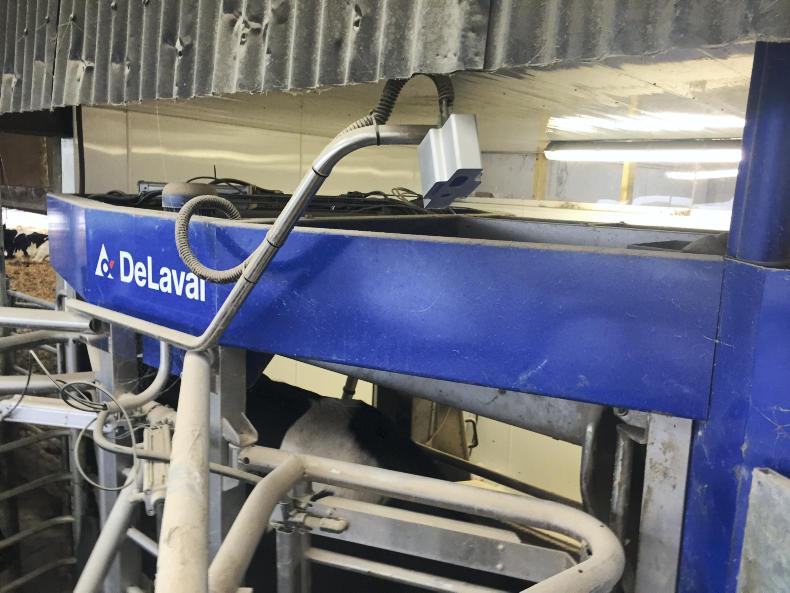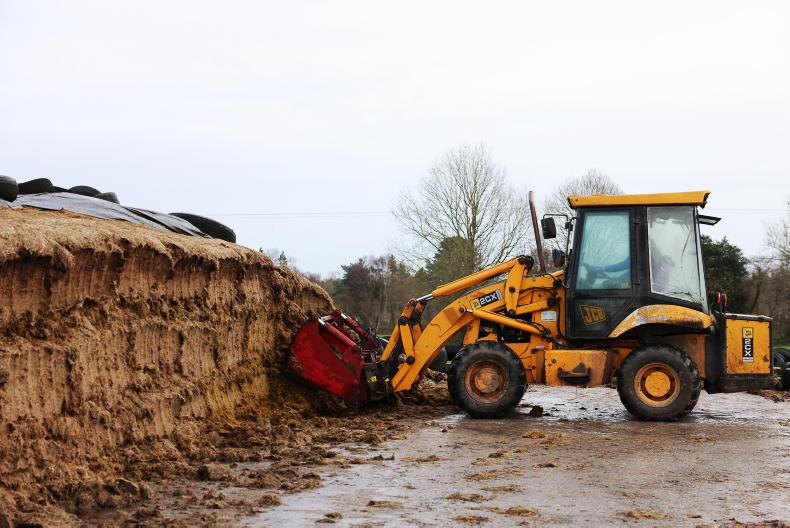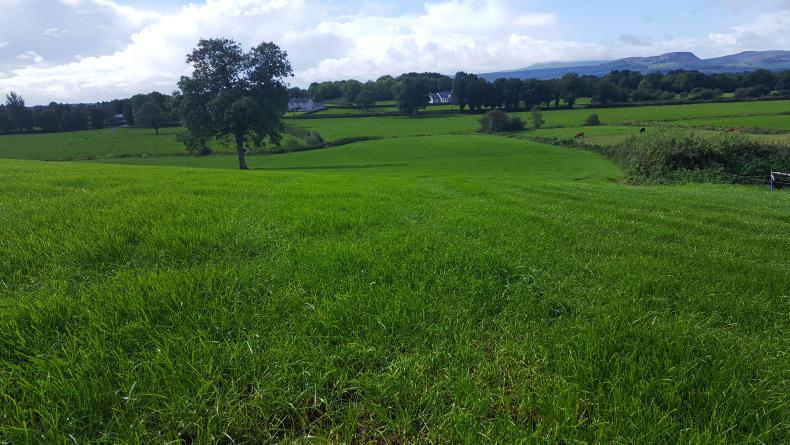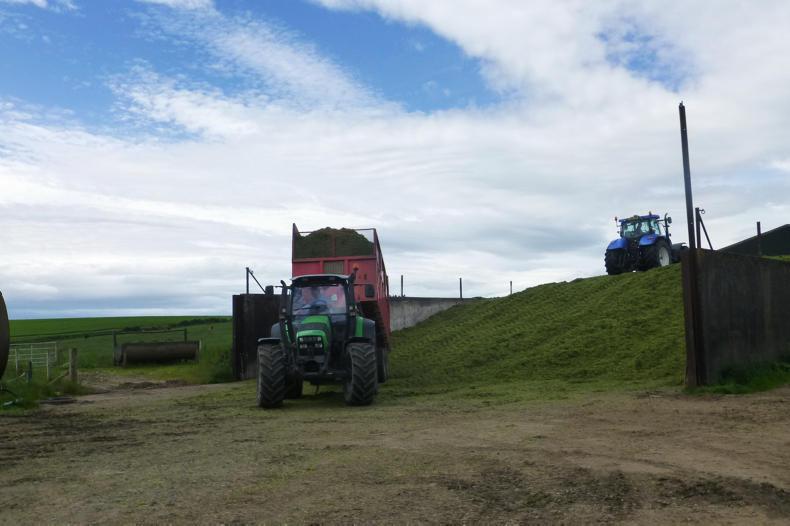When James Walsh was lying on the flat of his back at the Santry Sports Rehabilitation clinic in Dublin after getting a disk removed from his back, he knew things would have to change on the farm.
At the time, the 50 or so cows were being milked through a five-unit double-up parlour. Because of his back injury, James’s ability to continue to milk cows himself was severely curtailed.
His options were to hire in relief milkers, invest in technology, or get out of cows. The dairy enterprise is only one component of the Walsh farm, with substantial tillage and beef enterprises run also. In total, there are 120ha on the farm at Kilmuckridge, Co Wexford.
After some investigating, James decided to go down the automation route and signed the deal on a new DeLaval VMS robotic milking unit in September 2014. The new system was up and running in March 2015.
In May this year, a new DeLaval body condition score (BCS) camera was installed on the robot. The camera is placed on the exit from the robot and it takes hundreds of pictures per second of the cows as they pass through. Using algorithms, formulated based on the breed of the cow, the camera can assess the level of fat on a cow based on the roundness of her flesh and her angularity.
“The main reason for installing the BCS camera was to make more efficient use of feed. It makes no sense to be feeding extra meal to a cow that is gaining BCS over and above her target, so we cut back on meal when BCS is increasing,” James explains.
“The BCS has knock-on benefits for fertility too. Because BCS is now being managed constantly, cows that are in peak yield and losing condition are fed extra meal to prevent excessive body condition score loss.”
Since graduating from Agricultural Science in UCD this year, James’s son Andrew has returned home to help out on the farm full-time. James’s father George keeps an eye on things also. This year they milked 60 cows and have plans to increase numbers further, seeing the long-term potential of the robot at 80 to 90 cows.
The cows are mostly spring-calving but some cows are now calving in the autumn too, to keep the robot working over the winter.
The robot is set up for ABC grazing, with the cows moving between each area every eight hours. There are two pre-selection gates that the cows must pass through before they get to visit the robot. These gates determine whether the cow is due to milked or not. If she is not due to be milked, the gate will either send the cow back to the same paddock she came from, or else to a new paddock if it is after the time change.
Cows are selected for milking based on their expected yield, or time since last milking. By pre-selecting the cows that get to visit the robot, the amount of milk harvested per hour or per day is increased because only cows that are due to be milked enter the robot.
The farm also has what is called a feed first gate. This is set up for when the cows are milking indoors in the shed. A one-way gate allows the cows into the feed passage where they get silage.
To get back into the straw lieback, or to visit the robot, they must pass through the feed first gate. This gate determines whether the cows need to be milked or not. It will only let a maximum of five cows into the holding pen for the robot.
Meal is fed to the cows on a feed-to-yield basis, so cows that are milking the most will get fed the most meal. James explained that in summer, when grass is plentiful, some cows would only be on 1kg per day of meal while some of the higher yielding cows could be on up to 8kg per day.
“This is where the BCS camera really comes into its own. The feed to yield optimises meal feeding based on milk yield and the camera optimises meal feeding based on body condition score.”
The two systems are deliberately not linked and any changes to meal feeding based on body condition score is done manually by James and Andrew. Once a week or so they go through the cows and make changes based on their BCS.
The system tracks cows BCS over time, relative to an optimum BCS curve. Cows that are outside of the normal range are flagged on the farm computer. Sometimes this is due to a health issue such as ketosis or acidosis and the camera provides an early warning system for Andrew and James of a sick cow.
Grass is still a key part of the Walsh dairy enterprise. The herd was still grazing last week, despite the bad weather. Last year, they were at grass until 3 December and out again in early February. Andrew and James don’t routinely measure the whole farm at a time, but they do measure how much grass they are allocating on a daily basis.
The grazing area is split in three and fresh grass is allocated every day in each area. Post-grazing residuals are excellent. James has been using clover for the last 20 years and cow paddocks are reseeded every five to seven years in rotation with tillage.
There is 22.5ha allocated to the dairy cows which is a stocking rate of 2.67 cows/ha with some of the first-cut silage taken off this area.
Meal feeding has increased since the robot was installed. Cows are now fed on average 1.25t/cow of meal, up about 0.25t/cow since the robot was installed. However, more milk is being produced too, with an extra 90,200 litres of milk produced from an extra six cows in 2015 and an extra 78,000 litres produced so far this year from an extra six heifers.
Milk yield per cow has increased from 5,500l to over 7,000l this year. Milk solids per cow is expected to be 520kg this year. Cows are fed a mix of rolled barley/soya and beet pulp nuts along with minerals and vitamins. The barley is grown and rolled on the farm.
“We get the meal at first cost, I think it makes more sense to feed it and send it out the gate in the milk lorry than sell the grain,” says James.

James is a former contestant in the NDC Quality Milk Awards and average SCC hasn’t changed much since the robot was installed, hovering around the 60 to 70,000 mark.
Between it all, about €200,000 was spent installing the robot. This includes the alterations to an existing shed and a new slatted tank. The robot and pre-selection gates cost €140,000. No grant was claimed and the existing bulk tank was used. The BCS cost an extra €5,000 plus an annual charge of €420. James estimates the annual running cost of the robot, including repairs, services and consumables at €4,600 per year. He pays a monthly service fee of €270 covering repairs and breakdowns.
Read more
What will farming be like in 10 years' time?
Autonomous tractors: are they the future?
Instant silage analysis
Will robots replace linear scorers?
Mapping the farm with an app
Agri technology, helping to save lives around machinery
When James Walsh was lying on the flat of his back at the Santry Sports Rehabilitation clinic in Dublin after getting a disk removed from his back, he knew things would have to change on the farm.
At the time, the 50 or so cows were being milked through a five-unit double-up parlour. Because of his back injury, James’s ability to continue to milk cows himself was severely curtailed.
His options were to hire in relief milkers, invest in technology, or get out of cows. The dairy enterprise is only one component of the Walsh farm, with substantial tillage and beef enterprises run also. In total, there are 120ha on the farm at Kilmuckridge, Co Wexford.
After some investigating, James decided to go down the automation route and signed the deal on a new DeLaval VMS robotic milking unit in September 2014. The new system was up and running in March 2015.
In May this year, a new DeLaval body condition score (BCS) camera was installed on the robot. The camera is placed on the exit from the robot and it takes hundreds of pictures per second of the cows as they pass through. Using algorithms, formulated based on the breed of the cow, the camera can assess the level of fat on a cow based on the roundness of her flesh and her angularity.
“The main reason for installing the BCS camera was to make more efficient use of feed. It makes no sense to be feeding extra meal to a cow that is gaining BCS over and above her target, so we cut back on meal when BCS is increasing,” James explains.
“The BCS has knock-on benefits for fertility too. Because BCS is now being managed constantly, cows that are in peak yield and losing condition are fed extra meal to prevent excessive body condition score loss.”
Since graduating from Agricultural Science in UCD this year, James’s son Andrew has returned home to help out on the farm full-time. James’s father George keeps an eye on things also. This year they milked 60 cows and have plans to increase numbers further, seeing the long-term potential of the robot at 80 to 90 cows.
The cows are mostly spring-calving but some cows are now calving in the autumn too, to keep the robot working over the winter.
The robot is set up for ABC grazing, with the cows moving between each area every eight hours. There are two pre-selection gates that the cows must pass through before they get to visit the robot. These gates determine whether the cow is due to milked or not. If she is not due to be milked, the gate will either send the cow back to the same paddock she came from, or else to a new paddock if it is after the time change.
Cows are selected for milking based on their expected yield, or time since last milking. By pre-selecting the cows that get to visit the robot, the amount of milk harvested per hour or per day is increased because only cows that are due to be milked enter the robot.
The farm also has what is called a feed first gate. This is set up for when the cows are milking indoors in the shed. A one-way gate allows the cows into the feed passage where they get silage.
To get back into the straw lieback, or to visit the robot, they must pass through the feed first gate. This gate determines whether the cows need to be milked or not. It will only let a maximum of five cows into the holding pen for the robot.
Meal is fed to the cows on a feed-to-yield basis, so cows that are milking the most will get fed the most meal. James explained that in summer, when grass is plentiful, some cows would only be on 1kg per day of meal while some of the higher yielding cows could be on up to 8kg per day.
“This is where the BCS camera really comes into its own. The feed to yield optimises meal feeding based on milk yield and the camera optimises meal feeding based on body condition score.”
The two systems are deliberately not linked and any changes to meal feeding based on body condition score is done manually by James and Andrew. Once a week or so they go through the cows and make changes based on their BCS.
The system tracks cows BCS over time, relative to an optimum BCS curve. Cows that are outside of the normal range are flagged on the farm computer. Sometimes this is due to a health issue such as ketosis or acidosis and the camera provides an early warning system for Andrew and James of a sick cow.
Grass is still a key part of the Walsh dairy enterprise. The herd was still grazing last week, despite the bad weather. Last year, they were at grass until 3 December and out again in early February. Andrew and James don’t routinely measure the whole farm at a time, but they do measure how much grass they are allocating on a daily basis.
The grazing area is split in three and fresh grass is allocated every day in each area. Post-grazing residuals are excellent. James has been using clover for the last 20 years and cow paddocks are reseeded every five to seven years in rotation with tillage.
There is 22.5ha allocated to the dairy cows which is a stocking rate of 2.67 cows/ha with some of the first-cut silage taken off this area.
Meal feeding has increased since the robot was installed. Cows are now fed on average 1.25t/cow of meal, up about 0.25t/cow since the robot was installed. However, more milk is being produced too, with an extra 90,200 litres of milk produced from an extra six cows in 2015 and an extra 78,000 litres produced so far this year from an extra six heifers.
Milk yield per cow has increased from 5,500l to over 7,000l this year. Milk solids per cow is expected to be 520kg this year. Cows are fed a mix of rolled barley/soya and beet pulp nuts along with minerals and vitamins. The barley is grown and rolled on the farm.
“We get the meal at first cost, I think it makes more sense to feed it and send it out the gate in the milk lorry than sell the grain,” says James.

James is a former contestant in the NDC Quality Milk Awards and average SCC hasn’t changed much since the robot was installed, hovering around the 60 to 70,000 mark.
Between it all, about €200,000 was spent installing the robot. This includes the alterations to an existing shed and a new slatted tank. The robot and pre-selection gates cost €140,000. No grant was claimed and the existing bulk tank was used. The BCS cost an extra €5,000 plus an annual charge of €420. James estimates the annual running cost of the robot, including repairs, services and consumables at €4,600 per year. He pays a monthly service fee of €270 covering repairs and breakdowns.
Read more
What will farming be like in 10 years' time?
Autonomous tractors: are they the future?
Instant silage analysis
Will robots replace linear scorers?
Mapping the farm with an app
Agri technology, helping to save lives around machinery














SHARING OPTIONS